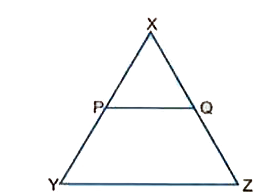In Fig. 3, given, XP/PY = XQ/QZ = 3. If the area of ΔXYZis32cm2, then find the area of the quadrilateral PYZQ.

Step by step video & image solution for In Fig. 3, given, XP/PY = XQ/QZ = 3. If the area of DeltaXYZ is 32cm^(2), then find the area of the quadrilateral PYZQ. by Maths experts to help you in doubts & scoring excellent marks in Class 10 exams.
Updated on:21/07/2023Topper's Solved these Questions
- MODEL QUESTION PAPER -2 [UNSOLVED]BOOK - VK GLOBAL PUBLICATIONCHAPTER - MODEL QUESTION PAPER -2 [UNSOLVED]EXERCISE - SECTION-D
10 Videos
- MODEL QUESTION PAPER -2 [UNSOLVED]BOOK - VK GLOBAL PUBLICATIONCHAPTER - MODEL QUESTION PAPER -2 [UNSOLVED]EXERCISE - SECTION-D
10 Videos
- MODEL QUESTION PAPER - 9 [UNSOLVED]BOOK - VK GLOBAL PUBLICATIONCHAPTER - MODEL QUESTION PAPER - 9 [UNSOLVED]EXERCISE - SECTION - D
7 Videos
- MODEL QUESTION PAPER -7 BOOK - VK GLOBAL PUBLICATIONCHAPTER - MODEL QUESTION PAPER -7 EXERCISE - SECTION -D
8 Videos
Similar Questions
Knowledge Check

In the figure given above, ABCD is a quadrilateral and BPDQ is parallelogram. AR = 50 cm, CQ = 70 cm, BR = 60, and PR = 40 cm. If the area of the quadrilateral ABCD is 15,600cm2, then find the area of then find the area of the parallelogram BPDQ (in cm2).A9460B8460C7500D9000The diagonal of a cube is 2√3 cm. Find the surface area of the cube.
A15 sq cmB18 sq cmC25 sq cmD24 sq cm
Perimeter of a Δ is 32 cm & inradius is 3 cm. Find the area of Δ.
View SolutionIf A(-7, 5), B(-6, -7), C(-3, -8) and D(2, 3) are the vertices of a quadrilateral ABCD then find the area of the quadrilateral.
View SolutionFind the area of ΔABC, if a=2,b=3 and c=5 cm
View SolutionIf the length of the edge of a cube is 3.2 cm, then the total surface area of the cube is
View SolutionRatio of the area of ΔWXY to the area of ΔWZY is 3:4 (Fig. 9.33). If the area of ΔWXZis56cm2 and WY = 8 cm, find the lengths of XY and YZ.

View SolutionThe radius and height of a cone are in the ratio 4:3. The area of the base is 154cm2. Find the area of the curved surface. l
View Solution

